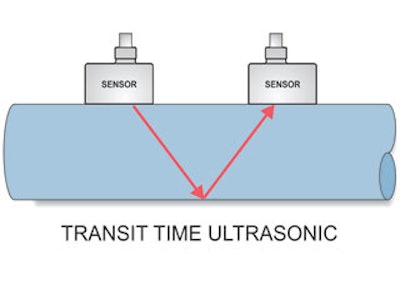
Doppler and transit time are two very popular types of flow meters for non-invasive measurement of flow in full pipes. They are both ultrasonic and both measure flow by using sensors clamped onto the outside of a pipe. But they actually work best in opposite applications and success in your installation depends on understanding the differences and making the right choice.
Ultrasonics are a mature technology and widely used in industrial applications. The clamp-on transducer design is popular because the flowmeters can be installed without cutting the pipe or shutting down flow. There is no pressure drop and the non-contacting transducers are immune to chemicals, abrasives, and pressure. They work on non-conductive fluids, including oils, and are not affected by electromagnetic fields or radiation. They have a wide temperature operating range plus excellent properties of repeatability and reliable operation
Ultrasound is sound generated above the human hearing range—above 20 kHz. Both Doppler and Transit Time flowmeter technologies are called “ultrasonic” because they operate far above the frequencies or sound range that we can hear.
At the heart of each ultrasonic transducer is a piezo-electric crystal. They are glass disks about the size of a coin. These crystals are polarized and expand or pulse a minute amount when electrical energy is applied to the surface electrodes. As it pulses, the transducer emits an ultrasonic beam approximately 5 degrees wide at an angle designed to efficiently pass through a pipe wall. The returning echo (pressure pulse) impacts a second passive crystal and creates electrical energy. This is the received signal in a doppler or transit time transducer.
What’s The Difference?
Transit time flowmeters must have a pair of transducers. One transducer transmits sound while the other acts as a receiver. As the name suggests, transit time flowmeters measure the time it takes for an ultrasonic signal transmitted from one sensor to cross a pipe and be received by a second sensor. Upstream and downstream time measurements are compared. With no flow, the transit time would be equal in both directions. With flow, sound will travel faster in the direction of flow and slower against the flow. Because the ultrasonic signal must cross the pipe to a receiving transducer, the fluid must not contain a significant concentration of bubbles or solids—otherwise the high frequency sound will be attenuated and too weak to traverse the pipe.
Transit time transducers typically operate in the 1-2 MHz frequencies. Higher frequency designs are normally used in smaller pipes and lower frequencies for large pipes up to several meters in diameter. So operators must select transducer models/frequencies according to the application.
Transducers can be installed on opposite sides of the pipe so that the ultrasonic signal travels once diagonally across the pipe. This method is called ‘Z’ mounting and typically is used in large pipes or weak signal applications. The most common mounting configuration is ‘V’ mode where transducers are installed on the same side of the pipe with the sound bouncing off the opposite pipe wall so that it crosses the pipe twice. ‘W’ mode mounting is often used in very small diameter pipes where the signal crosses the pipe four times. The flow meter’s software will normally specify the recommended mounting method and transducer separation distance as calibration parameters are entered into the calibration menu.
Doppler flow meters use the principal that sound waves will be returned to a transmitter at an altered frequency if reflectors in the liquid are in motion. This frequency shift is in direct proportion to the velocity of the liquid. It is precisely measured by the instrument to calculate the flow rate. So the liquid must contain gas bubbles or solids for the Doppler measurement to work. Doppler transducers usually operate at 640 kHz to 1 MHz frequencies and work on a wide range of pipe diameters. Dual-head Doppler flowmeters are available from some manufacturers, although they are somewhat more difficult to install. They are often confused with transit time meters because dual-head Doppler meters also use separate transmit and receive transducers. Although they look very similar to transit time, dual-head Doppler instruments are still measuring only the frequency shift of the transmitted signal from one transducer to the received signal by another. Whether single-head or dual-head design, Doppler instruments always work by measuring the frequency shift of signals reflected from moving particles or bubbles in the fluid.
Two Technologies, One Decision
Doppler flowmeters work best in dirty or aerated liquids like wastewater and slurries. Transit Time flowmeters work with clean liquids like water, oils, and chemicals. Select the right ultrasonic technology for your application and enjoy the benefits of non-contacting flow measurement including easy, low-cost installation and highly repeatable readings.


















